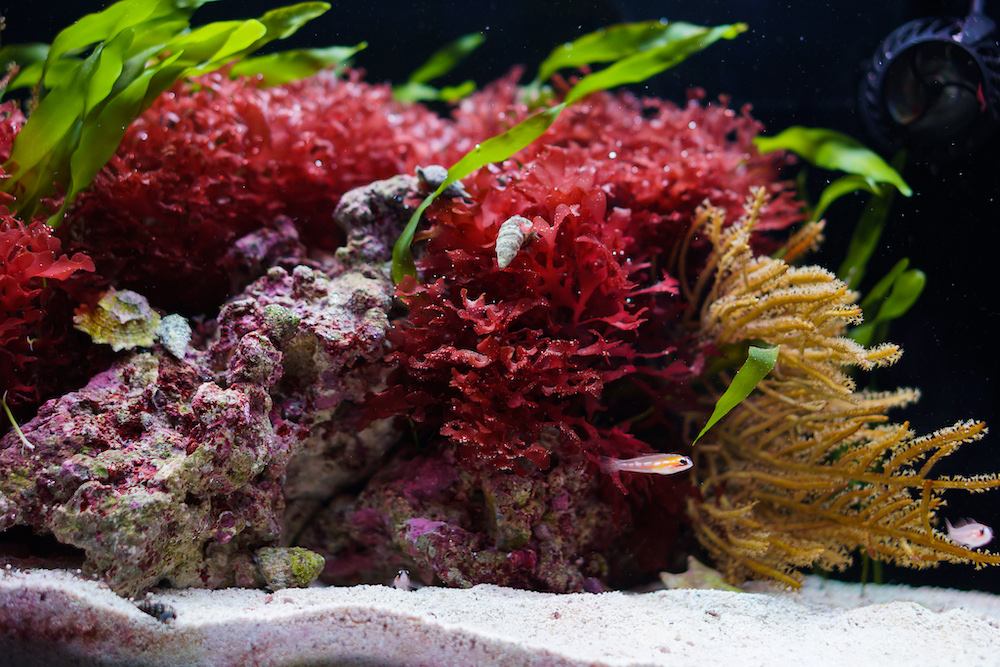How do I Acclimate my Macroalgae?
For a lot of hobbyists, macroalgae is a critical part of their reef aquarium filtration. Macroalgae serves many purposes, such as removing nutrients from the water, competing with pest algae, providing a habitat for copepods, and becoming a replenishing food source for herbivore fish.
Fortunately, AlgaeBarn is a great supplier of macroalgae. Macroalgae form AlgaeBarn is kept in its own separate system, making the chance for pests very unlikely. Even after that, all macroalgae is cleaned, treated, quarantined, and inspected before being sent to you.
That's what we do at AlgaeBarn on our end, but what should you do on your end? That's what we will go over in this article. We'll talk about cleaning your macroalgae and acclimating it to your new aquarium.
Should you acclimate your macroalgae?
Although macroalgae is generally a hardy organism, it can benefit from acclimation. Macroalgae does not experience the same kind of stress that fish and inverts do, but they can experience some level of stress. Unless you put your macroalgae in a highly intolerable environment, it will not completely die. However, some part of the macroalgae can die, causing you to lose some macroalgae. Dead macroalgae can cause negative effects on the surviving macroalgae as well. The reason acclimating macroalgae is important is to limit die-off. If you can acclimate your macroalgae (why couldn't you?), you should.
What causes macroalgae to become "stressed"?
Macroalgae does not experience any psychological stress the way fish or inverts might. It can still experience stress in a sense, though. The three main factors that cause macroalgae stress are changes in pH, temperature, and light. Changes in salinity can also cause macroalgae to become stressed, but that is more important once the macroalgae is in your aquarium. Knowing that, you need to make the change in temperature, pH, and light more gradual. Next, we'll talk about how you can do that.
How to acclimate your macroalgae
The first thing you should do is slightly open the lid of the jar that the macroalgae is in. The reason for this is to adjust the pH levels slowly. With the lid slightly open, the carbon dioxide levels and oxygen levels will become normal, and the pH will gradually rise. Next, acclimate the macroalgae to the temperature of the tank. You can do this by floating the macroalgae in the aquarium, or if your aquarium generally runs at room temperature (it doesn't heavily rely on a heater or chiller to regulate temperature), just leave it in the room for about 15 minutes. After this, you should rinse the macroalgae using water from your aquarium. Put the water into a bowl and rinse the macroalgae in the bowl. The goal is to clean off any detritus or nuisance algae. If you see any pests, get rid of those as well. After cleaning the macroalgae, remove it from the bowl and put it in the tank. Do not add the water from the bowl back to the tank. The final thing you need to acclimate your macroalgae to is light. Like corals, macroalgae can be shocked by sudden intense lighting. During the first day, leave the refugium lights (or whatever light the macroalgae is under) off. If you have and adjustable light, dim the lights for the next day. You can start the light levels low and slowly raise them over a week. If you have an AI light, you can do this automatically with the acclimation setting.
That is how you acclimate macroalgae. It is easy and not as complicated as acclimating fish or inverts. Don't bother with drip acclimation or anything like that. Just open the lid for a bit, let the temperature adjust, rinse the macroalgae, and finally add it to the aquarium. Then, let the macroalgae get used to lights. That's it! You now have the knowledge to add macroalgae to your aquarium successfully. Happy reefing!
Because all of the macroalgae we offer has already been inspected/pretreated to remove potential pest organisms, you can spend more time with your fish!

Related Articles
How to Acclimate Nudibranches
Berghia Acclimation Guide The Berghia will be stunned when they arrive. They will appear lifeless and many times are balled up with the other berghia. They are NOT dead, do not panic. Follow the instructions below: • Immediately remove the lid ...How do I Acclimate My Captive Bred Fish?
If you just bought a captive-bred fish, congratulations. You made the right choice! Captive-bred fish are much hardier and better adapted for aquarium life. Purchasing captive-bred fish also has no impact on the wild populations of fish and wild ...How do I Acclimate My Captive Bred Invertebrates?
Most hobbyists know how to acclimate marine fish to a new aquarium. If you don't, checkout this article. When it comes to inverts, things get a little shaky. This is mostly because the term "invertebrates" refers to the widest range of marine ...How do I Acclimate my Copepods?
Hobbyists are often told to carefully acclimate new additions to their aquarium. Fish and inverts such as snails and shrimp need to be acclimate (corals do not), but what about copepods? Are you supposed to drip acclimate them or float them? Do they ...What is the best way to add Copepods to my tank?
Many hobbyists are seeing the benefits of adding copepods to their aquariums. Whether it is to control algae, cleanup detritus, feed finicky fish, or all three, many hobbyists, beginner and experienced alike, want copepods in their aquariums. If ...